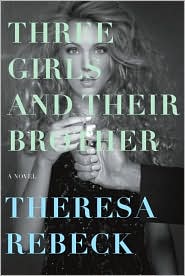 In a world insatiable for celebrity access, where there are reality shows about reality shows, and magazines shriek that the stars are “just like us!” whenever one buys a latte, pops out a baby, or heads for rehab, it seems redundant to ask if we’ve gone too far. But that’s exactly what Theresa Rebeck does with Three Girls and Their Brother, and, for the most part, it works.
In a world insatiable for celebrity access, where there are reality shows about reality shows, and magazines shriek that the stars are “just like us!” whenever one buys a latte, pops out a baby, or heads for rehab, it seems redundant to ask if we’ve gone too far. But that’s exactly what Theresa Rebeck does with Three Girls and Their Brother, and, for the most part, it works.
As the story opens, Amelia, Polly, and Daria are just three teenage girls with gorgeous red hair and a literary genius for a great-grandfather. But when they wind up in a New Yorker photo spread and are hailed as the It Girls of the moment, their lives begin to unravel deliciously. Their titular brother, Phillip, a stand-in for Holden Caulfield (right down to his disdain for the “creeps” who populate Manhattan) is the ideal foil. And although the story progresses through each of the siblings’ voices, it’s strongest while under his observant care.
Instead of scenes, Rebeck has created snapshots; moments captured by photographers or paparazzi define the characters’ paths. The inciting New Yorker feature is quickly followed by paparazzi shots in restaurants and bars, photo spreads in magazines, and a billboard in Times Square, each photo advancing the plot and further entangling the characters. It’s a clever device. More questionable is the need to employ the siblings as multiple narrators—a choice that becomes especially weak at the book’s end, as the older sisters dissolve into one another.
This is a first novel for Rebeck, an accomplished playwright, and her theatre chops are undeniable. Her dialogue is rooted in flesh and blood, and her gesture is mediated with dramatic precision. Some of the best moments of the story unfold after Amelia, the youngest sister, finds herself working in an off-Broadway theatre and meets the people who bring it to life – actors, directors, and crew members writ with such affection and attention to detail that you sense Rebeck knows them personally – because, of course, she does. It’s real, and Amelia can’t help but respond.
Unfortunately, the main characters don’t fare as well. There’s a brief mention that Daria, the oldest sister, was molested by her father, but the incident passes quickly, almost weightlessly, on its way back to more superficial and unspecific plotlines. This is where Rebeck the playwright trips herself up. In the hands of skilled actors, Phillip, Amelia, Polly, Daria, and even their grating stereotype of a mother, could have come alive. But on the page, they seem rather indistinguishable – less unreliable narrators and more unaware bystanders to their own lives. The most intriguing and uniquely wrought character of the entire story, a Lower East Side hairdresser named La Aura, becomes our hero not because she tells the truth, but rather because we believe she might actually exist.
Then again, perhaps that’s the point. After all, a 30-page tabloid spun into a 300-page novel is still an escape hatch from everyday life, beckoning us with glossy photos of people we’ll never know.





